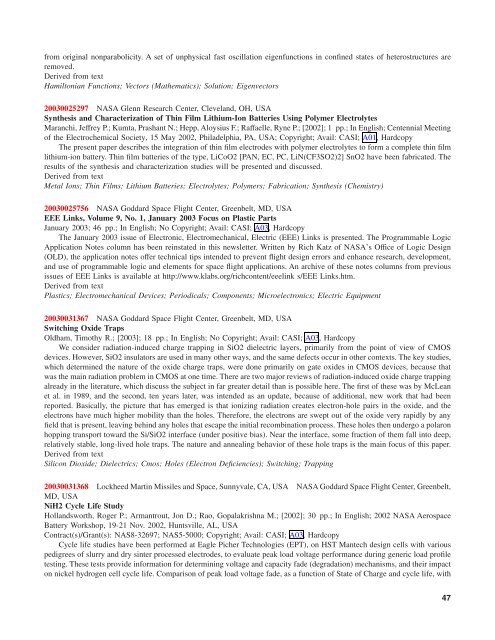You also want an ePaper? Increase the reach of your titles
YUMPU automatically turns print PDFs into web optimized ePapers that Google loves.
from original nonparabolicity. A set of unphysical fast oscillation eigenfunctions in confined states of heterostructures are<br />
removed.<br />
Derived from text<br />
Hamiltonian Functions; Vectors (Mathematics); Solution; Eigenvectors<br />
20030025297 NASA Glenn Research Center, Cleveland, OH, USA<br />
Synthesis and Characterization of Thin Film Lithium-Ion Batteries Using Polymer Electrolytes<br />
Maranchi, Jeffrey P.; Kumta, Prashant N.; Hepp, Aloysius F.; Raffaelle, Ryne P.; [2002]; 1 pp.; In English; Centennial Meeting<br />
of the Electrochemical Society, 15 May 2002, Philadelphia, PA, USA; Copyright; Avail: CASI; A01, Hardcopy<br />
The present paper describes the integration of thin film electrodes with polymer electrolytes to form a complete thin film<br />
lithium-ion battery. Thin film batteries of the type, LiCoO2 [PAN, EC, PC, LiN(CF3SO2)2] SnO2 have been fabricated. The<br />
results of the synthesis and characterization studies will be presented and discussed.<br />
Derived from text<br />
Metal Ions; Thin Films; Lithium Batteries; Electrolytes; Polymers; Fabrication; Synthesis (Chemistry)<br />
20030025756 NASA Goddard Space Flight Center, Greenbelt, MD, USA<br />
EEE Links, Volume 9, No. 1, January 2003 Focus on Plastic Parts<br />
January 2003; 46 pp.; In English; No Copyright; Avail: CASI; A03, Hardcopy<br />
The January 2003 issue of Electronic, Electromechanical, Electric (EEE) Links is presented. The Programmable Logic<br />
Application Notes column has been reinstated in this newsletter. Written by Rich Katz of NASA’s Office of Logic Design<br />
(OLD), the application notes offer technical tips intended to prevent flight design errors and enhance research, development,<br />
and use of programmable logic and elements for space flight applications. An archive of these notes columns from previous<br />
issues of EEE Links is available at http://www.klabs.org/richcontent/eeelink s/EEE Links.htm.<br />
Derived from text<br />
Plastics; Electromechanical Devices; Periodicals; Components; Microelectronics; Electric Equipment<br />
20030031367 NASA Goddard Space Flight Center, Greenbelt, MD, USA<br />
Switching Oxide Traps<br />
Oldham, Timothy R.; [2003]; 18 pp.; In English; No Copyright; Avail: CASI; A03, Hardcopy<br />
We consider radiation-induced charge trapping in SiO2 dielectric layers, primarily from the point of view of CMOS<br />
devices. However, SiO2 insulators are used in many other ways, and the same defects occur in other contexts. The key studies,<br />
which determined the nature of the oxide charge traps, were done primarily on gate oxides in CMOS devices, because that<br />
was the main radiation problem in CMOS at one time. There are two major reviews of radiation-induced oxide charge trapping<br />
already in the literature, which discuss the subject in far greater detail than is possible here. The first of these was by McLean<br />
et al. in 1989, and the second, ten years later, was intended as an update, because of additional, new work that had been<br />
reported. Basically, the picture that has emerged is that ionizing radiation creates electron-hole pairs in the oxide, and the<br />
electrons have much higher mobility than the holes. Therefore, the electrons are swept out of the oxide very rapidly by any<br />
field that is present, leaving behind any holes that escape the initial recombination process. These holes then undergo a polaron<br />
hopping transport toward the Si/SiO2 interface (under positive bias). Near the interface, some fraction of them fall into deep,<br />
relatively stable, long-lived hole traps. The nature and annealing behavior of these hole traps is the main focus of this paper.<br />
Derived from text<br />
Silicon Dioxide; Dielectrics; Cmos; Holes (Electron Deficiencies); Switching; Trapping<br />
20030031368 Lockheed Martin Missiles and Space, Sunnyvale, CA, USA NASA Goddard Space Flight Center, Greenbelt,<br />
MD, USA<br />
NiH2 Cycle Life Study<br />
Hollandsworth, Roger P.; Armantrout, Jon D.; Rao, Gopalakrishna M.; [2002]; 30 pp.; In English; 2002 NASA Aerospace<br />
Battery Workshop, 19-21 Nov. 2002, Huntsville, AL, USA<br />
Contract(s)/Grant(s): NAS8-32697; NAS5-5000; Copyright; Avail: CASI; A03, Hardcopy<br />
Cycle life studies have been performed at Eagle Picher Technologies (EPT), on HST Mantech design cells with various<br />
pedigrees of slurry and dry sinter processed electrodes, to evaluate peak load voltage performance during generic load pro<strong>file</strong><br />
testing. These tests provide information for determining voltage and capacity fade (degradation) mechanisms, and their impact<br />
on nickel hydrogen cell cycle life. Comparison of peak load voltage fade, as a function of State of Charge and cycle life, with<br />
47
















